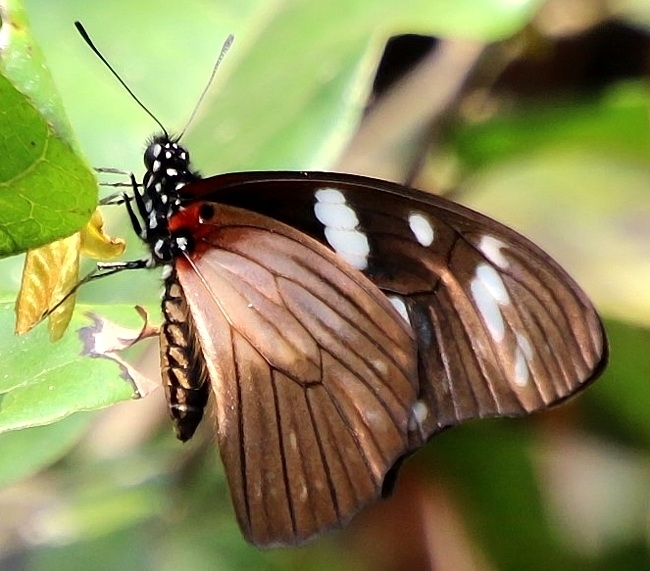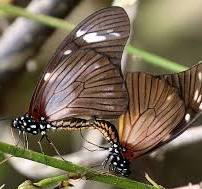Graphium almansor is an African butterfly with more names than anybody needs, unless it might be an online entrepreneur market-testing different brands.
Graphium is the genus name, the general type of butterfly. So far, so good, except that some scientists are complaining that a lot of very different-looking butterflies are all classified as Graphium. They say that the genus Graphium can be divided into clearly distinguished species groups, and these groups might be described as separate genera. Some would like to list almansor as a member of the new proposed genus Arisbe. (Arisbe was the name of at least three minor characters in ancient Greek literature.)
The rule many of us learned in primary school, or whenever we learned these things, was that if plants or animals reproduce normally with one another, they belong to the same species. If they can be crossbred but do not normally crossbreed, or produce only sterile offspring, they belong to the same genus. But it turns out that, for most lifeforms, nobody has ever actually tested this, and anyway there are possible DNA profiles that may prevent individuals in the same species from reproducing successfully, especially with known close relatives.
Anyway, the earliest naturalists started a tradition of naming Swallowtail species after heroes of literature. Almansor, or Almansur or Almanzo, was a hero of history and legend, a Muslim ruler in Spain. Though the Muslim Moors were colonizers and were rejected by the indigenous people of Spain, some individual Moors were well liked. Almansor made war on Christians but, as a devout Muslim, he was seen as a good war chief. Many Muslims and even a few Christians named children, if not after him, then after other Moors who shared his name. So this African butterfly is named after a hero who was of African descent.
But shouldn't it have an English name? It has a few. The structure of its wings resembles that of another butterfly called the White Lady, so it's sometimes been called Almansor's White Lady, or Honrath's White Lady, after the naturalist who gave it its Latin name. Obviously only about half of a species can be "ladies" and this butterfly's wings normally show more black or dark gray than white.
Photo posted by Butati, who credited it to Paul Oliver. Subspecies uganda is described as having darker wings than other subspecies, but no subspecies of almansor could be described as a white butterfly.
It is also called the Friar Graphium. No connection with any monastic order is given as a reason for this. The wing color pattern of this butterfly can resemble the wing color pattern of another species with a different shape, in a butterfly family nicknamed the Clerics (see below), and the species Graphium almansor seems to mimic is called the Friar. It is not associated with any monastic order, either.
It has been called the Albertine Rift Butterfly, identifying it with a place where it's found, but it's found in other places too.
Then, just to make its list of names completely ridiculous, it's sometimes called a White Lady Swordtail. The butterfly's hind wings have no tails.
It has been reported in Angola, Burundi, Cameroon, the Central African Republic, Congo, Ethiopia, Gabon, Ghana, Guinea, the Ivory Coast, Kenya, Nigeria, Rwanda, Sudan, Tanzania, Togo, Uganda, Zaire, and Zambia. One author trying to trace reports of this butterfly found that many place names given have been changed; he was unable to identify some places where the butterfly was found many years ago. In no country is it very common; it's one of those butterflies whose population levels are tied directly to its host plant, so only a few butterflies in a few specific local areas. It is not believed to be particularly threatened.
Its host plants are bushes in the genus Pseudospondias, which is thought to be distantly "related" to sumac bushes and to cashew trees. Sometimes used in herbal medicine, these bushes are inedible and contain biochemicals with some toxicity, as many plants large butterflies eat do. Several other animals eat Pseudospondias, and Graphium almansor is considered a lower-toicity species that mimics more toxic butterflies.
There are subspecies: Graphium almansor almansor, G.a. birbiri, G.a. carchedonius, G.a. dufranei, G.a. escherichi, G. a. uganda, and G.a. wranghami. Clear explanations of the subspecies' names and differences probably have been printed in some book, but if they exist in digital form they're being suppressed by Google..The subspecies wranghami has been reclassified as a subspecies of Graphium poggianus, a similar looking but distinct species. The subspecies carchedonius is sometimes classified as a distinct species.
Both sexes look alike and are thought to be mimics of either of two species in the genus Amauris. These Amauris butterflies were thought to be Swallowtails, too, at first, but are now recognized as Nymphalids. Possibly as a joke about their black, white, and gray coloring the Amauris butterflies are sometimes called Clerics. The British got a bit silly when naming colonial butterfles. In the nineteenth century natural history was recommended as a pastime for children.
Nothing about the pre-adult stages of this butterfly's life seems to be known.






No comments:
Post a Comment